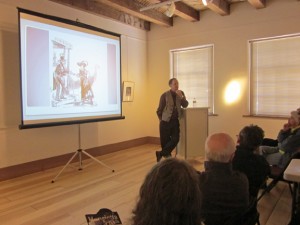As New Mexico was hoping, wishing and praying for statehood, 60 years’ worth of forces aligned against it.
The New York Times took the position that the outlaw frontier of New Mexico represented “the heart of our worst civilization.” Former Vice President and pro-slavery Sen. John C. Calhoun said in 1848 that “to incorporate Mexico would be the very first instance of incorporating an Indian race. … Ours, sir, is the government of a white race. The greatest misfortunes of Spanish America are … of placing these colored races on an equality with the white race.” Others considered the state too poor. Or too Catholic. Or too likely to side with northeastern senators than southern senators.
 At today’s Centennial Brainpower & Brownbags Lunch Lecture, New Mexico State University History Professor Jon Hunner led a full house of visitors through the hurdles and toward that fateful day, 100 years ago, when President Taft signed the territory into statehood. Along the way, he acquainted the audience with the unsavory characters of the Santa Fe Ring, “an equal-opportunity corrupter” consisting of lawyers, politicians, merchants and railroad men. “Of course,” he added, “corrupt organizations during the Gilded Age were nothing new.”
At today’s Centennial Brainpower & Brownbags Lunch Lecture, New Mexico State University History Professor Jon Hunner led a full house of visitors through the hurdles and toward that fateful day, 100 years ago, when President Taft signed the territory into statehood. Along the way, he acquainted the audience with the unsavory characters of the Santa Fe Ring, “an equal-opportunity corrupter” consisting of lawyers, politicians, merchants and railroad men. “Of course,” he added, “corrupt organizations during the Gilded Age were nothing new.”
There was also the tale of New Mexico Sen. Stephen B. Elkins ill-timed handshake of a colleague who had just, unbeknownst to Elkins, given a fiery anti-slavery speech, thereby costing the New Mexico statehood bill every Southern senator’s vote.
He also brought up an old wound: the surveyor mistake that gave a good (and oily) chunk of rightful and proper New Mexico land to the state of Texas–a still simmering matter that we wrote about in this blog post in 2009.
One of his best points is one well worth remembering in this Centennial year: “What New Mexico was in 1912, the United States has become over the past 100 years. We sent the first Hispanic senators to Congress, the first Hispanic representatives. We elected the nation’s first Hispanic governor.” The territory’s melting pot today mirrors a nation that once was ruled by Anglo men of means.
These monthly lectures, organized by Tomas Jaehn of the museum’s Fray Angelico Chavez History Library, are well worth putting on your calendar. (Next up: “Understanding William Howard Taft,” by Noel Pugach, professor emeritus of history at the University of New Mexico, April 18 at noon.) They’re free. The speakers are smart and interesting. And you walk away from a mere hour with enough knowledge to impress your friends, family and coworkers. Who knows, you might even get to sing.
At the end of today’s lecture, Hunner cajoled the crowd into joining him in a decidedly monotonic version of the official state song, “O, Fair New Mexico.” Next time, we’ll do a little warm-up first.
